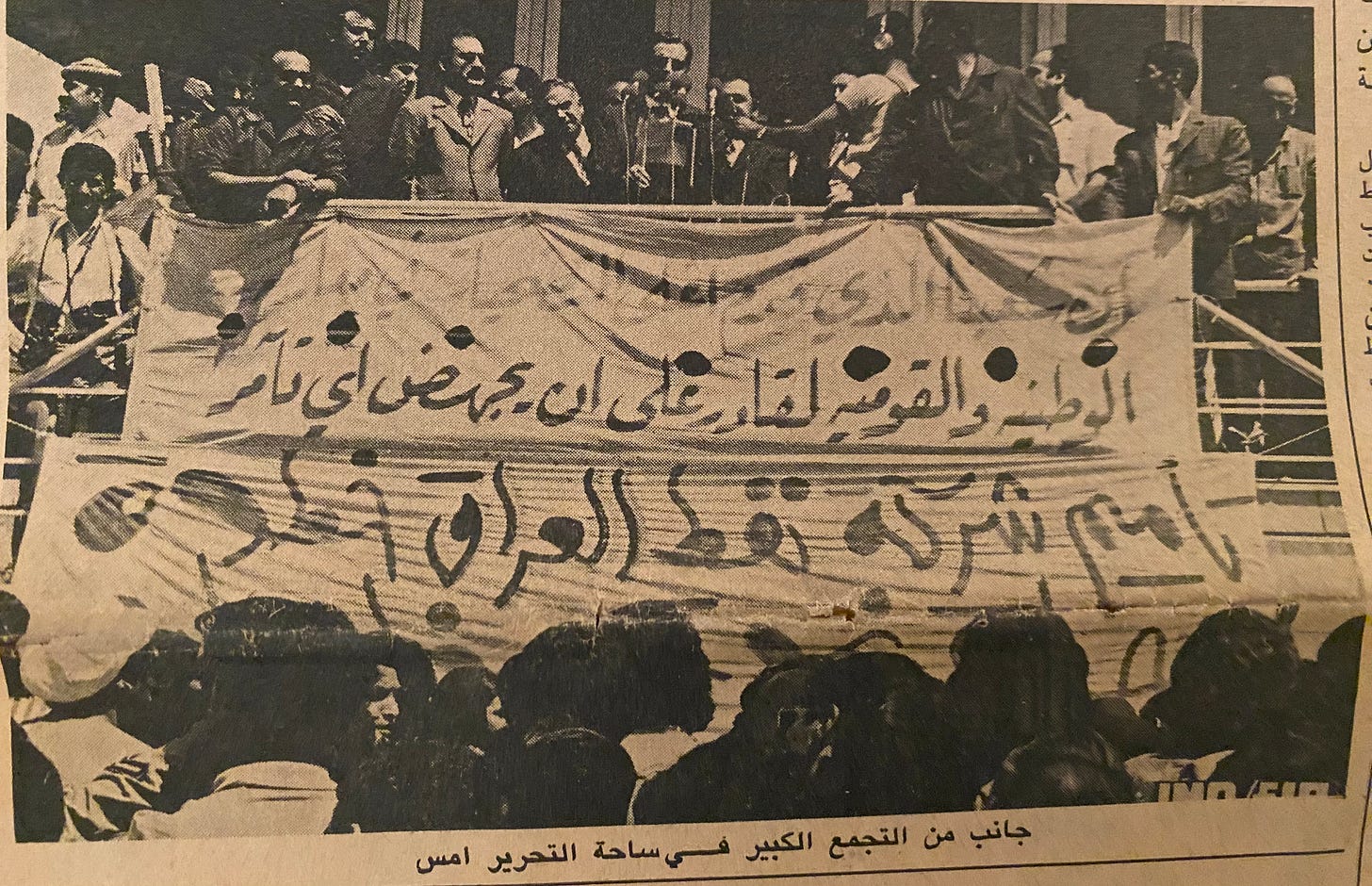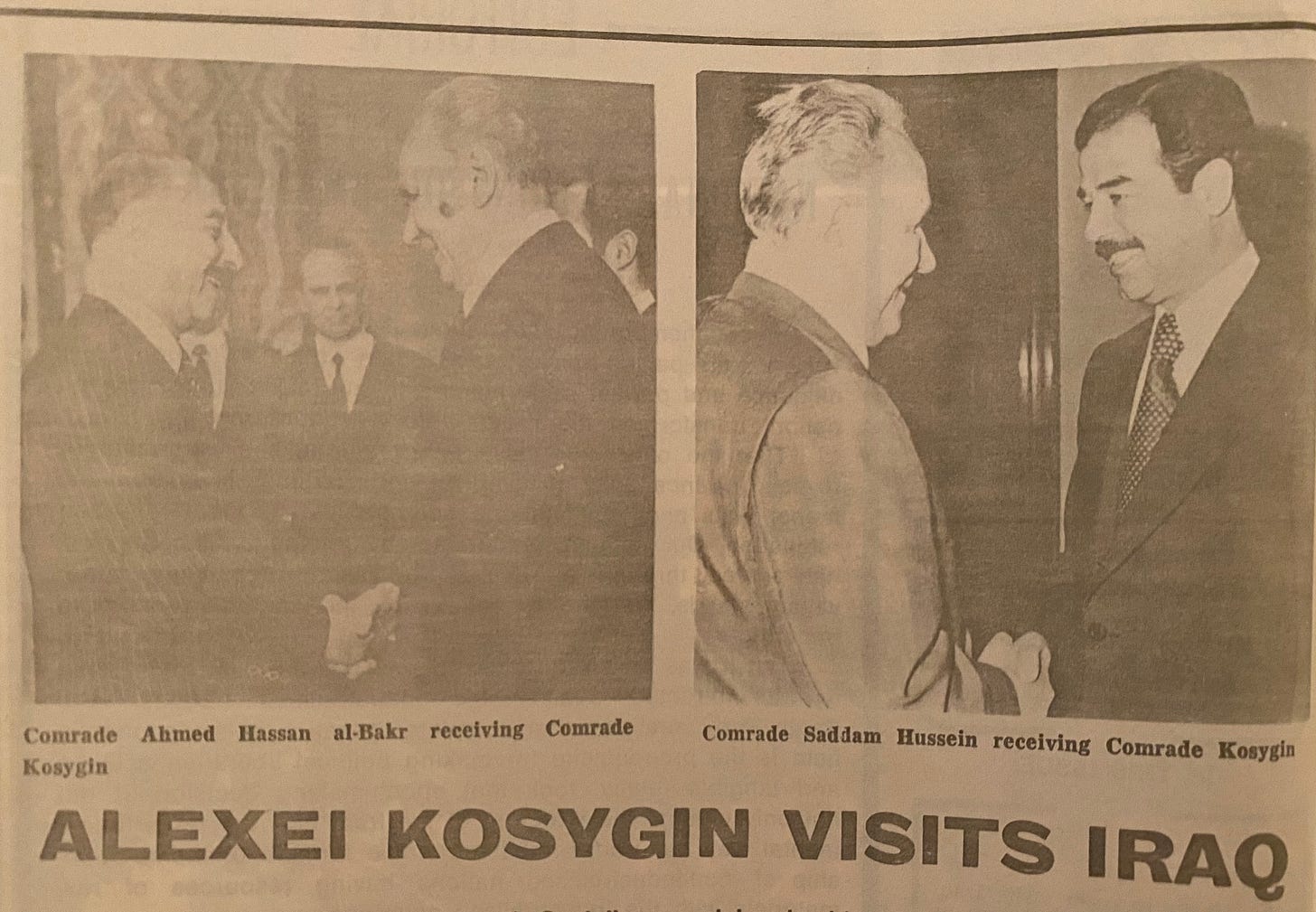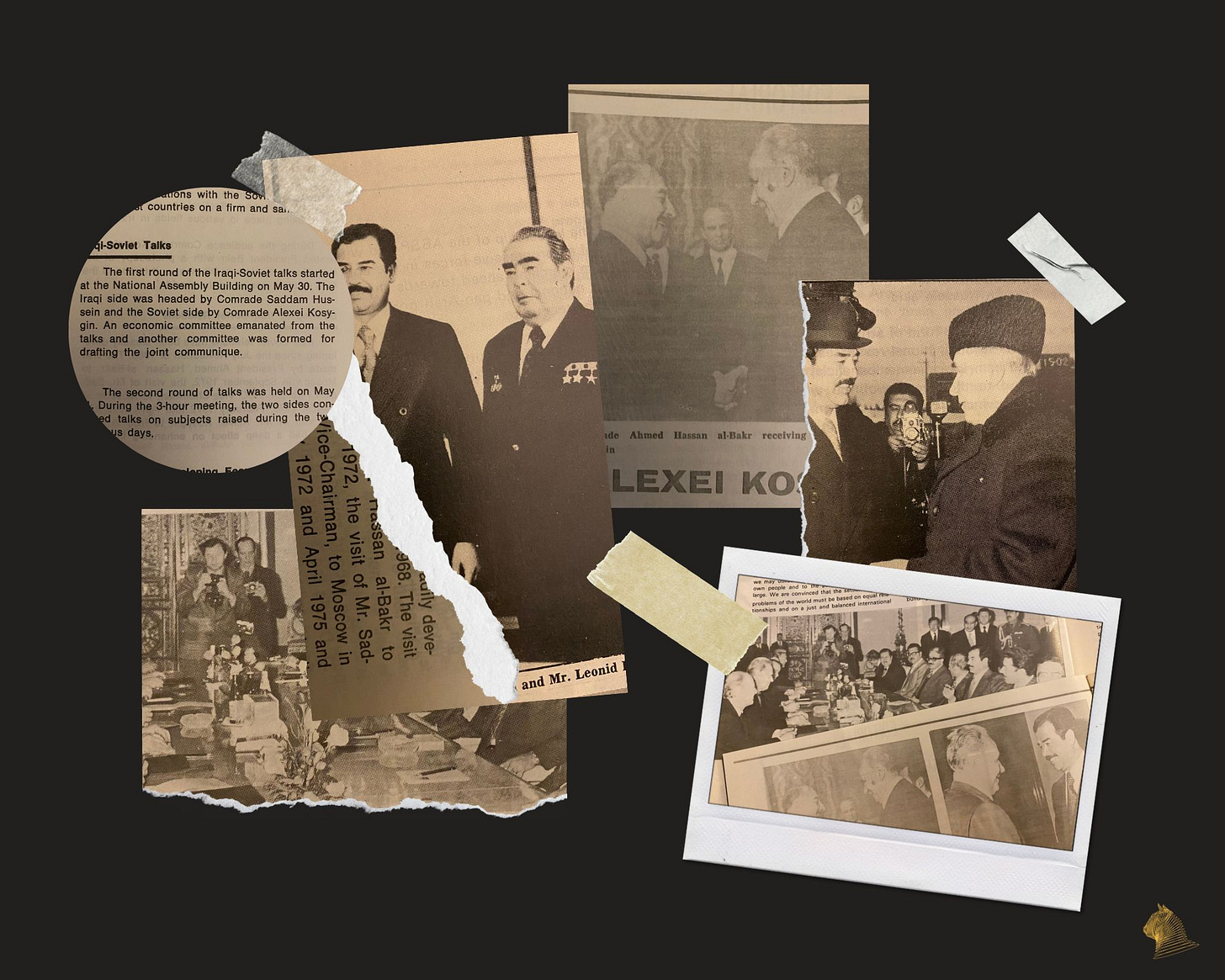It took this post some time to come together since I tweeted about it in March. Some of you reached out expressing their interest to learn more about Iraqi-Soviet relations in the 1970s – a subject that is rarely discussed. The post was sitting on the back burner, but here it is today. Thank you for reading my work, and as always, share your thoughts and memories.
Before I take the dive with you into this period in Iraq’s history, I would like to clarify a few things. Most of the information below is from two publications that were once published in Iraq: Iraq Today magazine (English version) and Al-Thawra newspaper (published in Arabic)—the official mouthpiece at that time of the Baath party, and they cover four years: 1972, 1975, 1976 , and 1977. I kept the details the way they are and did not meddle with the language used back then. I also cite background from The USSR and Iraq (published in 1991), a work by Professor Oles M. Smolansky and Professor Bettie M. Smolansky who untangle the complexities of Iraqi-Soviet relations in their book, and which are not mentioned in the two Iraqi publications I examine in this post. Readers, including researchers, may benefit from these. So, feel free to use the information with proper citation.
“Our Dear Friend”: Saddam Hussein in Moscow
In early 1977, Saddam Hussein visited Moscow for the fifth time since 1970. He was greeted by senior Russian officials, including the Soviet Prime Minister at the time, Alexei Kosygin, according to an article by Iraq Today magazine which captures the details of the visit. During that period, Saddam was the Deputy Secretary of the Regional Leadership (RL) of the Arab Baath Socialist Party (ABSP) and Vice-Chairman of the Revolution Command Council.
“Posters welcomed Saddam Hussein as ‘our dear friend’ and hailed the flourishing Iraqi-Soviet relations,” wrote Iraq Today (February 1-15, 1977).
During his visit, Saddam met with Leonid Ilyich Brezhnev, Secretary General of the Soviet Communist Party (CPSU), and held talks with Kosygin on bilateral relations, in addition to developments in the Arab region and on the international landscape.
“Political observers attached great importance to these deliberations and described their outcome as positive and fruitful,” Iraq Today wrote.
During a state luncheon organized by Soviet leaders at the Kremlin, Saddam discussed different subjects which Iraq Today summarized as follows:
“On the dubious developments unfolding in the Arab homeland Mr. Saddam Hussein warned: The imperialist, Zionist and reactionary forces are now attempting to intensify their conspiracies against the progressive forces in the Arab region. Their obvious aim is to ‘usurp our hard-won-successes and progressive gains.’ But despite their temporary success, ‘they will never be able to tame our people or attain their ultimate goals.’ This is because history tells us that the Arab nation does not surrender to capitulationist settlements such as those being dished up by imperialism, reaction, and the power trailing behind them. But vigorous support needs to be rendered to the progressive forces in the Arab World – ‘not as a necessity dictated by principles but as a prerequisite for facing imminent dangers.”
Kosygin: ‘The People of Iraq Can Count on the Support of the Soviet Union’
In his turn, Kosygin praised the status of Iraqi-Soviet relations during that period. He addressed the Iraqi delegation, saying:
“We wish you success in developing the profound social and economic transformations now taking place in Iraq. The successes you have so far achieved do enhance the international prestige of Iraq and broaden the prospects of its contribution to the cause of national liberation, progress, and peace in the Middle East… The people of Iraq may rest assured that they can count on the solidarity and support of the Soviet Union in their advance along the road of economic and social progress… We will go on rendering overall support to the Arab countries that have been waging a just struggle for national independence and social progress.”
In Brief: Iraqi-Soviet Relations
It was in 1944 when diplomatic relations between Iraq and the Soviet Union were first formed, according to Professor Oles M. Smolansky and Professor Bettie M. Smolansky, authors of the important book The USSR and Iraq (published in 1991). Following the overthrow of the British-installed monarchy in Iraq in 1958, Moscow was drawn to Iraq’s anti-western policies, and the two sides struck their first agreements on trade and military assistance towards the end of 1958. Another agreement on Iraq’s economic development was also signed the following year. The authors note that although relations between the two “cooled considerably” between 1960 and 1962 after Baghdad started persecuting the Iraqi Communist Party, Moscow did not cut its assistance programs to Iraq.
In 1969, Moscow agreed to send modern arms to Iraq, and in the following years, the two countries signed new economic and technical aid agreements.
In the early 1970s Baghdad needed Moscow’s support to achieve political and economic objectives, including on the issue of nationalizing the assets of western oil companies in Iraq. The Iraq Petroleum Company (IPC) had full control over Iraq’s national oil production. It was a consortium comprising companies like BP, Exxon, Mobil, CFP, Shell, and Partex, and it was eventually nationalized in 1972 as part of Iraqi maneuvers against foreign monopolies.

The political backing, according to the authors, was secured when Baghdad and Moscow signed the Treaty of Friendship in 1972. In return for Soviet support, Baghdad was willing to compromise on some sensitive issues, including the Communist Party in Iraq whose members were persecuted, and Kurdish autonomy which Moscow supported.
Iraq Today described the treaty as paving the way “for long-term co-operation in all vital spheres of common interest.” Since the signing of the treaty in 1972, the magazine continued saying, trade exchange between Iraq and the Soviet Union “has quadrupled” while economic cooperation saw the development during that period of “more than 100 important development projects” in the oil, energy, industry, and irrigation sectors. Meanwhile, Iraq’s defensive capabilities, according to Iraq Today, were “enhanced.”
In a separate article published in May 1976, and which addressed one of Kosygin’s visits to Baghdad (see photos below), Iraq Today said that Iraqi-Soviet relations had been “steadily developing since the July Revolution of 1969.” The magazine added that various visits by Iraqi and Soviet leaders to Moscow and Baghdad, had “a deep effect on enhancing the relations between the Revolution in Iraq and the friendly Soviet Union.” Iraq’s President during that period, Ahmed Hassan al-Bakr, visited Moscow in September 1972, and Saddam also went to Moscow in August 1970, February 1972, and April 1975, while Kosygin visited Iraq in April 1972 and later in May 1976.

However, and as Oles and Bettie Smolansky say in their book, Iraq’s relations with the Soviet Union were complex, and each country in the end was after its own interests. The two sides differed on various foreign policy issues related to the Horn of Africa, Iran, Afghanistan, and others, as well as on economic matters, such as Moscow’s reexports of Iraqi crude to western countries which other oil producers in the Arab region were boycotting during the Arab embargo of 1973.
With respect to Iraq’s international economic relations between 1976 and 1979, the authors note that the “center of gravity clearly and overwhelmingly shifted to the industrial West”. Iraq’s relations with some western countries like France was partly driven by Iraq’s need for western technology which the Soviet Union did not possess. Check my earlier work Iraq 1980: Strategy for Oil Exports to Europe, and the Threat of US Stockpiles here if you’re interested in that period. For more information on the multi-layered Iraqi-Soviet relations, I recommend reading Smolansky’s book, and Francis Fukuyama’s research paper (1980) The Soviet Union and Iraq Since 1968 here.
Examples of Soviet Projects in Iraq
In the energy sector, Al Thawra newspaper reported in March 1975 that the Soviet Technopromexport organization had signed a contract with Iraq for constructing a power plant in Dhi Qar in southern Iraq on a turnkey basis. That was the third contract Iraq signed with the Soviet Union. In 1971, the Soviet Union inked a contract with Iraq to expand a power plant in Al-Nujibiya in Basrah by 200 megawatts (MW) and later in 1974 a contract was signed to build a hydroelectric power station in Dukan in northern Iraq with a capacity of 240 MW.
In 1975, Iraq and the Soviet Union also signed trade agreements under which Moscow was supposed to export tractors, road construction equipment and grain harvesters to Iraq. Agreements were also signed for various other projects in different sectors. For instance, and according to a report prepared by veteran journalist Tewfik Mishlawi1 (1935-2012) on February 7, 1975, Soviet firms along with French and Danish companies were due to start constructing three major industrial plants in Iraq at a cost of over 380 million dollars at that time. One cement plant, with a capacity of 1,500 tons, was expected to be built in Iraq (most likely in Al-Muthanna; the word in the article was unclear) by the Soviet Technoexport organization at a cost of 34 million dollars.

These were the highlights for today. I will be revisiting this subject in future posts and with new material. Thank you very much for reading my work. My next post will be about oil tankers in Iraq! That’s all I can say now, so if you’re already curious, make sure you’ve subscribed to THE CHOKEPOINT to receive it in your inbox.
Mishlawi was also the owner and editor of the Middle East Reporter (MER) newsletter (1976-2012) which used to be published in Beirut. He was my mentor. The MER shared with me valuable historical documents which I used in this post and others.







